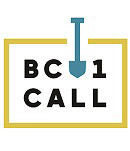Digging safety for contractors
Anytime you’re planning to break ground such as excavating a job site, you must click or call BC 1 Call in advance to request the location of underground gas and other utility lines on the property. Doing so could help you avoid safety hazards and costly repairs if you were to damage a buried gas or other utility line.
Three easy steps for safe digging
- Request location information — at least three business days before digging. There's no charge for this service and BC 1 Call will notify all member companies that have utilities buried at your job site.
Call BC 1 Call at 1-800-474-6886, or click:
- Plan where it’s safe to dig — within two to three business days, FortisBC will send you a map and information on where gas lines are buried on the site. If you need help understanding this information, call us at 1-888-822-6555 or follow these instructions on how to read your service maps.
- Find the line — use the map provided to mark the location of gas lines on your site. Dig by hand first to expose the gas line if you are working in this area. Don’t use any mechanized power equipment within one metre of the gas line in any direction.
Excavation safety around natural gas lines
Damaging a gas line when digging can create an unsafe situation for you, your employees and the public. It could also seriously delay your work schedule.
Download, print and share our Safe digging around gas lines brochure.
Dig by hand first
WorkSafeBC, Technical Safety BC and the BC Energy Regulator require hand digging to expose buried utility lines before digging with powered excavation equipment. You can review the relevant acts and regulations at bclaws.ca.
Guidelines for locating lines and hand digging
Before beginning any excavation or boring, you must locate the buried gas line and hand dig to expose the line. When exposing buried gas lines, the “no mechanized dig zone” refers to the area equal to the diameter of the gas pipe, plus one metre in any direction.
You must:
- have gas line information on site
- identify the location of the gas line and mark the line with paint or stakes until digging is underway
- confirm the location of the gas line by hand digging or with hydrovac excavation equipment
You may:
- use an electronic pipe locator to confirm the approximate location of the gas line
- use mechanical equipment only to remove surface cover or clear away loosened material down to the limits of the no mechanized dig zone before resuming hand digging
- use hydrovac excavation equipment if required within the no mechanized dig zone
- use mechanized power equipment to excavate past the boundary limits of the no mechanized dig zone
If you damage a natural gas line or smell gas
Stop what you’re doing, shut off any power tools or machinery and call the FortisBC Emergency Line at 1-800-663-9911 (24 hours) or 911 so we can inspect or repair the damage.
Contractors are responsible for notifying FortisBC and WorkSafeBC of damage to natural gas lines. We may seek to recover all associated costs from any person or organization who damages an underground gas line.
Damage prevention investigators
When one of our natural gas lines is damaged, we send a crew out immediately to repair it. We may also send one of our damage prevention investigators to determine how and why the gas line was damaged, and to educate the person or company involved so they don’t make the same mistakes again.
Read our blog post where the investigators share 7 damaging myths about digging safety and what happens after you hit a natural gas line.
Training opportunities
To promote safe digging practices, we offer training opportunities for contractors, municipal workers and other professionals working near underground utility lines. Contact Ada Nadison to learn more.
